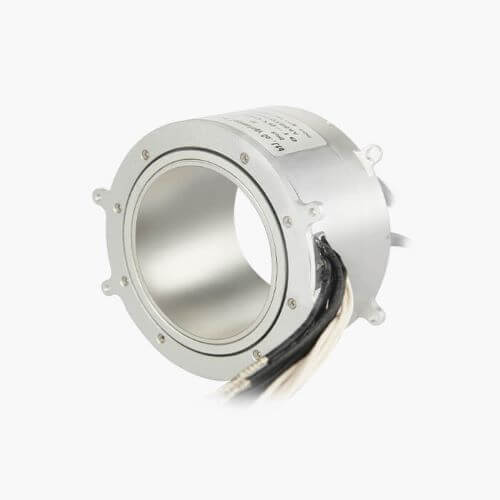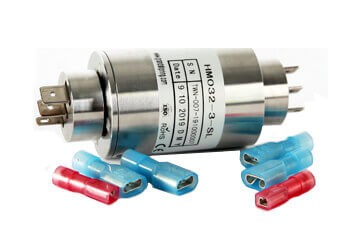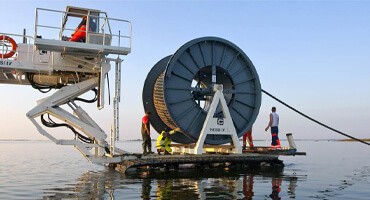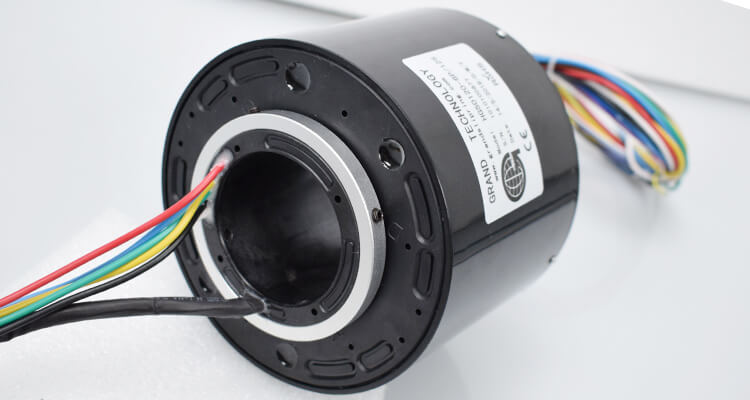As technology advances, an incredible range of equipment and devices relies on rotational movement for functionality. However, this rotational action, whether it’s in a wind turbine or an MRI machine, poses an intrinsic challenge: how can we transfer power and data signals across a rotating interface? The answer to this challenge lies in a device known commonly as a conductive slip ring.
A conductive slip ring is a device of import that seamlessly enables the transfer of power and data between stationary and rotating parts. Its discreet yet ubiquitous role underlines its relevance in industries as diverse as renewable energy, medical imaging, defense, and robotics, amongst others.
In this article, our objective is to provide readers with a comprehensive understanding of conductive slip rings, delving into their design principles, diverse uses, inherent benefits, and broad-spectrum applications. This guide is not limited to the mere elucidation of design and working principles, but instead seeks to furnish readers with practical insights, encapsulating expert knowledge and industry best practices.
Readers will gain a meaningful, hands-on understanding of conductive slip rings, whether they are engineers, designers, technicians, or technology enthusiasts. This knowledge is derived directly from experts in the field, professionals who spend their days designing and manufacturing these components and is thereby both in-depth and operational.
Through this article, it is our aim to provide a knowledge platform where the diverse aspects of a conductive slip ring can come together. By presenting an integrative narrative, we hope to offer a treasure trove of insights that can serve as a go-to guide for professionals and learners alike. It is our firm belief that knowledge that is both deep and wide prepares us best to exploit advances in technology, contribute to future developments, and, ultimately, benefit society.
What is a Conductive Slip Ring?
To truly appreciate the essence and value of any piece of technology, a fundamental understanding of how it works and what it does is critical. In the case of a conductive slip ring, it is an electromechanical device designed to transfer electrical power and signals between stationary and rotating parts in a system. However, beneath this simple description lies a complex piece of engineering.
At its core, the operation of a conductive slip ring relies on contact between brushes and rings. Inside this device, metallic brushes maintain steady contact with rotating rings around a central shaft. This arrangement allows electrical connections to remain intact even as one part of the device rotates. What makes this operation principle revolutionary is that it ensures continuous connectivity, despite rotational movement—nullifying restrictions on the number of rotations and enabling a flexible range of motion without twisting or tangling cables.
Beyond its operational mechanics, the significance of a conductive slip ring becomes increasingly vivid when we address its role in system design. Far from being a mere component, a conductive slip ring often forms the backbone of many electromechanical systems. This pivotal device makes it feasible for other parts of the system to perform their desired rotations freely, without sacrificing the integrity of data or power transfers, which forms the nervous system of such setups.
In particular, where engineers grapple with the transfer of power and data across rotational interfaces (especially in a fast-paced, data-heavy scenario), the conductive slip ring emerges as a significant, reliable, and efficient solution. Without these ingenious devices, we would face considerable limitations in the design and operation of systems that rely on continuous rotational movement. Therefore, understanding conductive slip rings is more than mere technical knowledge; it’s an insight into the essential mechanisms that enable much of our modern-day technological advances.
Types of Conductive Slip Rings
An appreciation of the diversity and versatility inherent in conductive slip rings is essential to understanding their far-reaching impacts across industries. This ranges from their size and shape to their method of operation — all of which can differ vastly. However, despite the diversity in types and configurations, the common principle of enabling continuous electrical connectivity across rotating interfaces remains consistent.
To give you a grasp of this versatility, consider a few common types of conductive slip rings:
Pancake Slip Rings
These are characterized by a disc-like, flat design. The slip ring’s components are arranged in a concentric manner, resulting in a reduced height slip ring configuration. This type is particularly suited for applications where space limitations are significant, especially in terms of axial height.

Through-Bore Slip Rings
As the name suggests, these slip rings feature a hollow shaft or a central hole ‘bore.’ This design allows for the passage of other components such as shafts, cables, or tubing through the center of the slip ring. Through-bore slip rings are ideal for applications demanding integration of the slip rings into a larger assembly.

Mercury Wetted Slip Rings
Despite being less common due to their environmental implications, they are worth mentioning due to their superior performance characteristics. These slip rings use liquid mercury to provide electrical connections, offering improved signal quality, reduced electrical noise, and reduced wear, compared to traditional style slip rings. However, safety and environmental concerns must be duly considered when choosing this type.

The depth and breadth of the types of conductive slip rings reveal how they can cater to differing application needs. The variation in types allows for creative problem-solving and adaptation to specific design constraints, be it space considerations, need for integration with other components, or signal quality necessities. Whether an application demands high rotational speed, minimum frictional wear, high current capacity, or specific input/output capability, there is likely a conductive slip ring tailored to suit those requirements.
Hence, understanding the different types provides both developers and users a tool to optimize their systems, ensuring operational efficiency, durability, and, ultimately, cost-effectiveness. This, indeed, is the unique power of a technology that can be adapted in so many ways – it offers us a spectrum of solutions rather than a one-size-fits-all-all approach.
Key Design Features of Conductive Slip Rings
The working details and application advantages of conductive slip rings are the visible manifestations of some central design features. These features form the fundamental blueprint while designing a conductive slip ring and significantly influence its performance and reliability.
Let’s turn our spotlight on some of these critical design elements:
- Contact Materials: Central to a slip ring’s operation are the materials employed for the rings and the brushes that maintain contact while the device rotates. Materials can vary from precious metals like gold and silver to more economical options like graphite or composite metal alloys. The choice of contact material is vital because it directly influences essential factors like conductivity, wear rate, and signal continuity, heavily impacting the slip ring’s long-term performance.
- Signal Handling: The information era requires the uninterrupted and accurate transfer of various types of signals – data, audio, video, or any other form – and this is a key determinant of slip ring design. Ensuring robust signal integrity while preventing distortion or loss during transmission is critical to the slip ring’s efficacy in various applications.
- Rotational Speed: Different applications demand different rotation speeds, and a slip ring’s design must accommodate these variations. High-speed applications necessitate not only a material choice that can withstand faster movement but also a design that minimizes unnecessary friction or heat.
- Size and Form Factor: The physical form, including the size and shape of a conductive slip ring, can be a defining aspect in some applications. Considerations related to integration within the system, space constraints, and ease of maintenance often make the size and form factors vital design elements.
The direct correlation between these design features and performance underlines their significance in creating an efficient and reliable conductive slip ring. These design elements are effectively like the DNA of the device; they determine its capabilities, characteristics, and ultimately, its fitness for a particular purpose.
Understanding the influence of such design features offers invaluable insights to both designers and users. For the designer, these points serve as the cornerstones of creating an efficient, highly functional product. For the user, it assists in a more informed selection process, securing a product best matched to their unique application requirements and ensuring the optimal operational performance of their systems.
Applications of Conductive Slip Rings
Conductive slip rings have established their significance in a myriad of industries, spanning various applications with diverse requirements. As a testament to their versatility, these devices can be found facilitating numerous applications where the transfer of power, data, or signals is mission-critical across rotational interfaces.
Let’s explore some of the notable industries and applications where conductive slip rings play a crucial role:
Renewable Energy: In wind turbines, both power generated by the turbine and essential control signals must be transmitted between the rotating blades and the stationary base. High-quality conductive slip rings are vital to ensuring wind turbines operate effectively and efficiently, even in the face of harsh environmental conditions.

Medical Equipment: When dealing with delicate systems like CT scanners and MRI machines, precise image capturing requires a continuous, smooth rotation while maintaining data integrity. Conductive slip rings ensure accurate electrical connections, enabling detailed imaging without interruption and promoting patient safety.

Defense: Conductive slip rings are employed in various military applications, including radar systems, missile guidance, and turret control. In these mission-critical settings, reliable power and signal transmission are essential, making the role of slip rings invaluable in defense situations.

Robotics: The rapidly growing field of robotic arms often calls for complex rotational arrangements. Conducive slip rings facilitate streamlined cable management and consistent, uninterrupted connectivity while adhering to demanding size, weight, and performance constraints.

Cable Reels: Cable reels used in industries such as construction, mining, and shipping demand continuous power and signal transmission as the reels unwind and wind back up. Conductive slip rings facilitate electrical continuity throughout the rotation, enhancing the functionality and utility of these cable management systems.、

This cursory overview offers a glimpse into the broad spectrum of applications where conductive slip rings prove indispensable. Their presence across various industries underscores their versatility and adaptive nature, as they address the unique requirements of each application. Far from being a niche component, conductive slip rings emerge as vital connectors bridging the gap between stationary and rotating systems, powering many of our modern-day innovations.
Selecting the Right Conductive Slip Ring
Successfully leveraging the capabilities of conductive slip rings begins with thoughtful selection based on your unique application requirements. The diversity of slip ring configurations, coupled with the multitude of industries they cater to, might make selection seem like a complex task.
However, incorporating some key decision-making benchmarks can guide users to a more informed, application-specific selection, creating systemic harmony and ensuring operational effectiveness. Here are some vital considerations to aid this process:
Define your Requirements: Conduct a thorough analysis of your system’s requirements. How many circuits do you need? What types of signals will be transmitted? What is the required rotational speed? What are the power ratings? This step is of utmost importance as it lays the groundwork for selecting the appropriate slip ring.
Consider the Environment: A slip ring’s operational environment plays a significant role in its selection. Factors like temperature, humidity, and exposure to dust or other contaminants should be considered. This will drive the decision for special sealing, type of contact material, or specific housing to ensure the slip ring’s durability and reliability.
Probe into Performance Specifications: Look into specific performance requirements such as life expectancy, electrical noise, and signal integrity, which can influence your selection. Be sure to check the manufacturer’s specifications for these benchmarks.
Attention to Size and Integration: Make sure the slip ring will fit in your system. Size and ease of integration often act as essential determinants and could make all the difference between a successful or failed implementation.
Consultation Advice: Reach out to manufacturers and industry experts for advice. Owing to their experience and technical know-how, they can help you make a more precise, suitable choice.
Cost-Benefit Analysis: Analyzing cost against operational benefits and lifecycle value often provides strategic guidance in choosing between alternatives, enabling you to make a balanced, economical choice.
The pursuit of the ‘right’ conductive slip ring for your system is a journey of specification alignment and synergy understanding. With these strategic guideposts, you can bridge the gap between application requirements and product offerings, ensuring you not only make an informed selection but also unlock the full potential of your system’s performance with a slip ring that truly complements its design.
The Future of Conductive Slip Rings
The world of conductive slip rings, like all aspects of technology, is not static. This sector has experienced a dynamic evolution, spurred by ongoing technological advances. These modifications have dramatically expanded the possibilities, enabling conductive slip rings to conquer more facets of our increasingly interconnected, power-hungry world.
As we gaze into this technological crystal ball, let’s explore some of the exciting trends shaping the destiny of conductive slip rings:
Miniaturization: As we sprint towards faster, more compact technology, slip rings are following suit. The trend of shrinking devices without compromising functionality necessitates the development of small, high-performance slip rings. We can expect to see miniaturized slip rings that maintain excellent signal integrity, particularly beneficial for space-constrained applications like robotics, medical devices, and wearable tech.
Intelligent Systems: The rise of smart, interconnected systems is heralding an era of “intelligent” slip rings. These devices could incorporate real-time condition monitoring, predictive maintenance, and self-diagnosis, enhancing reliability and performance. The integration of IoT technologies could also enable remote monitoring, significantly improving maintenance efficiency and system uptime.
Improved Materials: Technological advancements have led to the exploration and implementation of new materials that promise better conductivity, lesser wear and tear, and enhanced performance. The future might bring highly resilient, conductive materials that ensure longer service lives and minimal maintenance, significantly enhancing the effectiveness of the slip rings.
Environmentally Robust Designs: As machines are exposed to harsher environmental conditions, whether in mining, offshore wind farms, or space exploration, the demand for environmentally robust slip ring designs will likely grow. These slip rings would be resilient to high temperatures, humidity, dust, and corrosive environments, promising reliable performance where traditional slip rings may falter.
From smaller devices to smarter systems, the future of conductive slip rings carries the promise of significant transformation. While these trends hint at the direction, the actual speed and extent of these changes will continue to depend on scientific breakthroughs and technological convergence. However, one thing remains certain: conductive slip rings, as key enablers of rotational electrical interfaces, will continue to evolve, adapt, and flourish in the face of new challenges and opportunities.
Conclusion
Conductive slip rings are essential components in various industries and applications. By understanding their design aspects and gaining expert insights, you can make informed decisions when selecting and maintaining these components, ensuring a reliable and efficient system.
FAQs about Conductive Slip Rings
Given the technical nature of conductive slip rings, it is only natural to have questions or concerns regarding their operation, maintenance, and selection. Whether you’re a developer, integrator, or end user, understanding these devices can certainly feel overwhelming. To guide you through this maze, we’ve curated a list of frequently asked questions, along with professional responses to help clear any apprehensions.
Q: How long do conductive slip rings typically last?
A: The lifespan of a conductive slip ring is a function of its design, materials used, environment, and duty cycle. Some slip rings, especially those with heavy-duty specifications and high-quality materials, can run for millions of rotations with proper maintenance.
Q: How can I determine the right type of conductive slip ring for my needs?
A: When choosing a conductive slip ring, consider factors such as the rotational speed required, the type of signals to be transmitted, space constraints, and environmental conditions. Understanding your application requirements will guide you in selecting the appropriate slip ring configuration. It can also be advantageous to liaise with professional suppliers who provide technical consultation and customized solutions.
Q: Can conductive slip rings transmit data and power simultaneously?
A: Absolutely. The unique design of conductive slip rings enables them to transmit both data and power signals simultaneously. This characteristic is particularly crucial in applications that integrate power transmission with real-time data feeds.
Q: What are the maintenance requirements for conductive slip rings?
A: Regular maintenance ensures the longevity of the slip ring. This usually entails regular cleaning and inspection of the rotating contacts for wear or damage, and replacing worn-out components if necessary. However, the specifics depend on the slip ring type and the operating environment. Always refer to the manufacturer’s maintenance guidelines for accurate details.
Q: Can conductive slip rings operate in extreme environments?
A: Yes, specific slip rings are designed to withstand harsh operating conditions, including extreme temperatures, humidity, and high-vibration scenarios. However, such demands should be stated at the time of specification and selection to ensure the right design and material choice.
Addressing these concerns and questions reveals the importance of effective communication in breaking down the barriers that may make the world of conductive slip rings seem inaccessible. As we improve our understanding of these devices and clarify misconceptions, we can navigate the field with greater confidence, leveraging the true potential of this remarkable technology.
See What We Can Do

